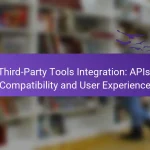The landscape of gamified learning has evolved dramatically in response to global events, particularly the COVID-19 pandemic, which has accelerated the integration of digital education tools. As educational institutions pivot to meet new demands, the focus on engaging, interactive experiences has intensified, prompting the adoption of innovative strategies that enhance learner engagement and personalization. Key market shifts, including the rise of mobile applications and increased investment in EdTech, underscore the growing need for flexible and accessible educational solutions tailored to diverse learning preferences.

How are global events shaping gamified learning trends?
Global events, particularly the COVID-19 pandemic, have significantly influenced gamified learning trends by accelerating the adoption of digital education tools and interactive content. As educational institutions adapt to changing circumstances, the demand for engaging, gamified experiences has surged, reshaping how learners interact with educational material.
Impact of COVID-19 on online education
The COVID-19 pandemic forced educational institutions worldwide to transition to online learning, highlighting the need for effective digital solutions. This shift led to an increased focus on gamified learning as educators sought to maintain student engagement in a virtual environment.
Many schools and universities incorporated game elements into their curricula to enhance motivation and participation. For example, platforms like Kahoot! and Quizizz became popular for their interactive quizzes, allowing students to compete and collaborate in real-time.
Rise of remote learning platforms
The demand for remote learning platforms has skyrocketed, with many new tools emerging to cater to diverse educational needs. Platforms such as Zoom, Microsoft Teams, and Google Classroom have integrated gamified elements to foster interaction and engagement among students.
These platforms often include features like leaderboards, badges, and rewards to encourage participation. Institutions are increasingly adopting these tools to create a more dynamic learning environment, which can lead to improved educational outcomes.
Increased demand for interactive content
As learners become accustomed to digital education, there is a growing demand for interactive content that enhances the learning experience. Gamified elements such as simulations, quizzes, and storytelling are being integrated into educational materials to make learning more engaging.
For instance, educational games that simulate real-world scenarios allow students to apply their knowledge in practical contexts. This approach not only boosts retention but also makes learning enjoyable, catering to various learning styles.

What adaptation strategies are effective for online courses?
Effective adaptation strategies for online courses include incorporating game mechanics, utilizing data analytics, and fostering social interaction among learners. These approaches enhance engagement, personalize learning experiences, and build a supportive learning community.
Incorporating game mechanics in curriculum
Incorporating game mechanics into the curriculum can significantly boost student motivation and engagement. This can include elements like points, badges, and leaderboards that reward progress and encourage competition.
For example, a course might offer badges for completing modules or a leaderboard that ranks students based on their quiz scores. These features can create a sense of achievement and drive learners to participate more actively.
Utilizing data analytics for personalized learning
Data analytics can help tailor online courses to meet individual learner needs by tracking progress and identifying areas for improvement. By analyzing user data, educators can offer personalized content, adaptive assessments, and targeted feedback.
For instance, if a student struggles with a particular topic, the system can recommend additional resources or practice exercises. This approach not only enhances learning outcomes but also allows for a more customized educational experience.
Engaging learners through social interaction
Engaging learners through social interaction fosters a sense of community and collaboration. Online courses can incorporate discussion forums, group projects, and peer reviews to encourage communication and teamwork.
For example, creating small groups for collaborative assignments can help students share ideas and learn from each other. This social aspect can reduce feelings of isolation often associated with online learning, making the experience more enjoyable and effective.

What are the key market shifts in gamified learning?
Key market shifts in gamified learning include the rise of mobile applications, increased investment in EdTech startups, and the development of hybrid learning models. These trends reflect a growing demand for engaging, flexible, and accessible educational solutions that cater to diverse learning preferences.
Growth of mobile learning applications
The growth of mobile learning applications has transformed how learners engage with educational content. With smartphones and tablets widely available, users can access gamified learning experiences anytime and anywhere, making education more convenient and personalized.
Developers are focusing on creating interactive and immersive experiences that leverage mobile features such as touch screens and location services. Popular examples include language learning apps like Duolingo and skill development platforms like Skillshare, which utilize gamification to enhance user engagement.
Investment trends in EdTech startups
Investment in EdTech startups has surged, driven by the demand for innovative learning solutions. Investors are increasingly recognizing the potential of gamified learning to improve educational outcomes, leading to significant funding rounds for companies that prioritize engaging and interactive content.
In recent years, funding for EdTech has reached billions of dollars globally, with notable investments in platforms that incorporate gamification. Startups focusing on adaptive learning technologies and personalized educational experiences are particularly attractive to investors seeking high growth potential.
Emergence of hybrid learning models
The emergence of hybrid learning models combines traditional classroom instruction with digital learning, creating a flexible educational environment. This approach allows educators to integrate gamified elements into both in-person and online settings, enhancing student engagement and motivation.
Hybrid models often utilize online platforms for assignments and assessments while maintaining face-to-face interaction for discussions and collaborative projects. This blend not only accommodates different learning styles but also prepares students for a workforce that increasingly values digital proficiency.

What are the prerequisites for implementing gamified learning?
To effectively implement gamified learning, organizations need to assess their learner demographics and evaluate their technology infrastructure. Understanding these prerequisites ensures that the gamified approach aligns with the learners’ needs and the available resources.
Understanding learner demographics
Identifying the demographics of your learners is crucial for tailoring gamified learning experiences. Consider factors such as age, educational background, and learning preferences, which can influence engagement levels and effectiveness.
For example, younger learners may respond better to fast-paced, visually engaging content, while older learners might prefer structured, informative formats. Conduct surveys or focus groups to gather insights about your audience’s preferences and motivations.
Assessing technology infrastructure
A robust technology infrastructure is essential for supporting gamified learning initiatives. Evaluate your current systems to ensure they can handle interactive content, track progress, and provide analytics.
Consider whether your learners have access to necessary devices and reliable internet connections. For instance, if your audience primarily uses mobile devices, ensure that your gamified content is optimized for mobile platforms. Regularly update your technology to keep pace with advancements and user expectations.

How do different regions adapt gamified learning?
Regions around the world adapt gamified learning by tailoring strategies to their cultural contexts, educational systems, and technological capabilities. This adaptation often involves integrating local themes, leveraging popular games, and aligning with educational standards to enhance engagement and effectiveness.
Gamification trends in North America
In North America, gamified learning is increasingly popular in both K-12 and higher education settings. Schools and universities utilize platforms that incorporate game mechanics, such as points, badges, and leaderboards, to motivate students and enhance participation.
For instance, many educational institutions have adopted tools like Kahoot! and Classcraft, which allow educators to create interactive quizzes and learning experiences. These platforms often emphasize collaboration and competition, appealing to the social dynamics of students.
European approaches to interactive education
European countries often focus on integrating gamified learning within their national curricula, emphasizing creativity and critical thinking. Countries like Finland and the Netherlands are known for their innovative educational practices, which include project-based learning and game-based assessments.
Additionally, the European Union supports various initiatives to promote digital education, encouraging the development of gamified learning resources. This includes funding for research and collaboration among educational institutions to share best practices and tools.
Asia-Pacific innovations in learning technology
The Asia-Pacific region is at the forefront of technological innovations in gamified learning, with countries like Japan and South Korea leading the way. Here, educational institutions often incorporate advanced technologies such as virtual reality (VR) and augmented reality (AR) to create immersive learning experiences.
For example, VR platforms are used in medical training and engineering courses, allowing students to practice skills in simulated environments. This hands-on approach not only enhances engagement but also improves retention and practical application of knowledge.

What are the future trends in gamified learning?
The future of gamified learning is shaped by advancements in technology and changing educational needs. Key trends include the integration of artificial intelligence and the expansion of virtual and augmented reality, which enhance engagement and personalize learning experiences.
Integration of AI in educational games
Artificial intelligence is increasingly being incorporated into educational games to create adaptive learning experiences. AI can analyze a learner’s progress and adjust difficulty levels in real-time, ensuring that challenges are tailored to individual skill levels.
For example, platforms like DreamBox Learning use AI to provide personalized math instruction, adapting content based on student performance. This approach not only keeps learners engaged but also helps identify areas needing improvement.
When implementing AI in educational games, consider the balance between automation and human oversight. While AI can enhance personalization, it’s crucial to maintain a supportive environment where educators can guide learning effectively.
Expansion of VR and AR in learning environments
Virtual reality (VR) and augmented reality (AR) are transforming gamified learning by providing immersive experiences that enhance understanding and retention. These technologies allow learners to explore complex concepts in a simulated environment, making abstract ideas more tangible.
For instance, platforms like Google Expeditions enable students to take virtual field trips, exploring historical sites or scientific phenomena without leaving the classroom. This hands-on approach can significantly boost engagement and motivation.
When integrating VR and AR, ensure that the technology aligns with learning objectives. Additionally, consider the accessibility of devices and the potential need for training educators to effectively use these tools in their teaching practices.


